
- Image via Wikipedia — Large-Flowered Bellwort
The bellworts seem to be delicate flowering herbs because of their dangling, single flowers and small size.
The image to the right is of a Large-Flowered Bellwort, so named for the size of its single flower. The yellow petals have a twist which helps to separate this kind of bellwort from other bellworts.
One bellwort in particular is a unique little plant. Its pointed oval leaves are pierced by the stem, except for the terminal leaves. The pierced leaves are called perfoliate leaves, which give the plant its name, Perfoliate Bellwort, Uvularia perfoliata. The stem and entire plant reaches about a foot tall at the most.
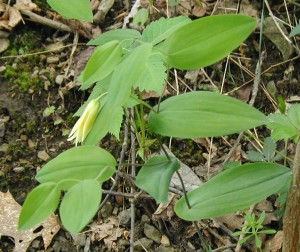
If you follow the stem of the perfoliate bellwort from the bottom up in the image above, you can see that a couple side stems branch off the main stem. However, only one of these forks will have a single terminal flower.
The lone lemon yellow bell-shaped flower hangs downward. Six elongated petals indicate the bellworts are members of the Lily Family, Liliaceae.
The flower is not as long as the leaf directly under it, which differentiates it from the large-flowered bellwort, Uvularia grandiflora. Also, the leaves of the large-flowered species are downy underneath unlike the smooth leaves of the perfoliate species.
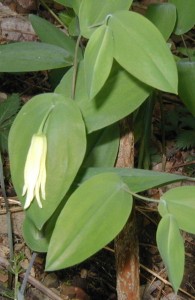
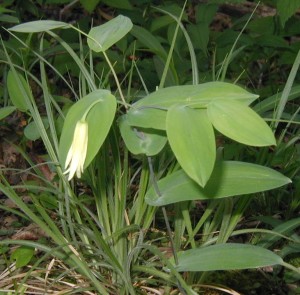
A couple weeks earlier the bellwort started blooming. Its leaves still retained some of the curl from opening up when the images below were taken 23 April 2010.
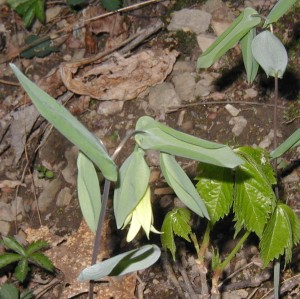
Two bellwort plants in the image above still retain a little curl in their leaves, signaling that these plant leaves are fresh and new.
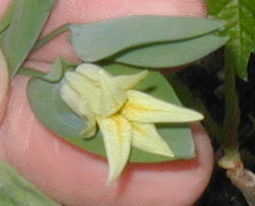
Another sign that we are looking at Perfoliate Bellwort instead of Large-Flowered Bellwort is the rough, orange center of the blossom. The large-flowered species has a smoother and more yellow center to the flower than the perfoliate species.
Eight or nine plants typically come up in this same area each Spring.
The Perfoliate Bellwort is a perennial herbaceous plant native to North America. In eastern woodlands it grows in the understory in the same types of places that you find black raspberry, blackberry, pasture rose, Solomon’s seal, Virginia creeper, poison ivy, and ferns.
Peterson’s Medicinal Plants Guide indicates that Native Americans used tea made from the roots to treat coughs, sore mouth, sore throat, and a number of ailments that appear to have inflammation at their root.
![Reblog this post [with Zemanta]](http://img.zemanta.com/reblog_e.png?x-id=6b046c79-67de-4eac-930d-f473b1e7d785)